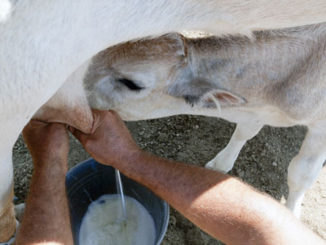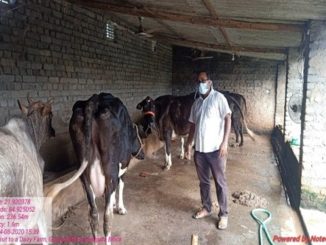Lumpy skin disease (LSD) also known as pseudourticaria, Neethling virus disease, exanthema nodularis bovis, knopvelsiekte. Lumpy skin disease of cattle and water buffalo caused by capripox virus belongs to family of Poxviridae Genus Capripox virus, the virus, which is closely related to the pox viruses of sheep and goats. Capripox virus is double stranded DNA virus, it is host specific. Virus can survive upto 35 days. Host for this virus is Cattle and Water buffalo. Lumpy skin disease is a viral disease of cattle that is spread by biting insects. and causes nodular skin lesions on the animal’s body Lumpy skin disease is primarily spread between animals by biting insects (vector), such as mosquitoes and biting flies. Less commonly, the virus may be spread by direct contact to the skin lesions, saliva, nasal discharge, milk, or semen of infected animals.
Economic Importance
Mostly farmers and National income is dependent on the livestock sector, LSD is a major problem for the livelihood of the farmer income mostly village population which is involve in the livestock sector the mortality rate and morbidity rate in case of LSD is respectively 1 to 5% and 10 to 20% in India. LSD causes considerable financial losses in livestock farmer and sector direct economic losses of LSD , mortality loss, milk production loss, beef loss and draft power loss, abortion, infertility long standing anoestrus poor growth in calves , loss of condition and damage to the hide and prolonged LSD predisposed to secondary Pneumonia , Peritonitis , Lameness in Bullocks ,Loss of treatment costs (medication and labour cost) per affected animal, and assessing the cost effectiveness of vaccination.
Epidemiology
Lumpy skin disease was first seen as an epidemic in Zambia in 1929. Initially, it was thought to be the result of either poisoning or a hypersensitivity to insect bites. Additional cases occurred between 1943 and 1945 in Botswana, Zimbabwe, and the Republic of South Africa. In 1989 there was an LSD outbreak in Israel. This outbreak was the first instance of LSD north of the Sahara Desert and outside of the African continent. This particular outbreak was thought to be the result of infected Stomoxys calcitrans being carried on wind from Ismailiya in Egypt. All of the cattle as well as small flocks of sheep and goats in the village were slaughtered. Throughout the past decade, LSD occurrences have been reported in Middle Eastern, European, and west Asian regions.
At the time of arrival of monsson the level of humidity become very high during moist weather leading to sever fly menace. These flies bite the livestock which causes hypersensitivity of the skin lesions but some time also spread diseases like cow pox which is lumpy skin disease among the animals.
Symptoms
The disease is characterized by fever, multiple firms, circumscribed skin nodules, and necrotic plaques in the mucous membranes, enlarged superficial lymph nodes, mastitis, orchitis and swelling of the peripheral lymph nodes. Fever that may exceed 41°C. Marked reduction in milk yield in lactating cattle. Depression/ Dullness, anorexia and emaciation. Rhinitis. Vesicles, erosions and ulcers may develop in the mucous membranes of the mouth and alimentary tract and in the trachea and lungs. Limbs and other ventral parts of the body, such as the dewlap, brisket, scrotum and vulva, may be oedematous, causing the animal to be reluctant to move. Pregnant cows may abort and be in anoestrus for several months. Disease can vary from mild to severe; younger animals are generally more severely affected. Animals will have a fever, be lethargic and unwilling to eat. Animals may have discharge from the eyes and nose, drop in milk production and weight loss. The most apparent sign will be multiple nodules on the body, including the muzzle, nostrils, head, neck, back, legs, scrotum, perineum, udder, eyelids, nasal and oral mucosa, and tail. Skin lesions appear in 1-2 days, extending all over the skin, but are most obvious on face, eyelids and ears, perineum and tail. Mortality peaks about two weeks after the onset of the skin lesions. These nodules may leak fluid and have an ulcerated center. Nodules can also develop in gastrointestinal tract, especially the abomasum (true stomach), as well as the trachea and lungs, resulting in primary and secondary pneumonia. Lameness may occur from inflammation of the tendons, and severe swelling of the brisket and legs. This lameness can be permanent with severe damage to tendons and joints from secondary bacterial infections. Permanent damage may occur to teats and mammary glands due to secondary bacterial infections and mastitis. Abortion and intrauterine infection are possible; temporary or permanent sterility in both bulls and cows may occur.
Transmission
Capripox viruses are very resistant and remain viable for long periods, on or off the animal host e.g. they may persist for up to 6 months in shaded animal pens, and for at least 3 months in dry scabs on the fleece, skin and hair from infected animals. Transmission of virus by contact with infected animals, their aerosols, nasal secretions, saliva or dried scabs. The viruses are also readily transported on clothes and equipment. Insects e.g. the stable fly (Stomoxys calcitrans) act sometimes as mechanical vectors. Transmission of virus can be within 50 km radius.
Treatment
Unfortunately, there are no specific antiviral drugs available for the treatment of lumpy skin disease. The only treatment available is supportive care of cattle. This can include treatment of skin lesions using wound care sprays and the use of antibiotics to prevent secondary skin infections and pneumonia. Anti-inflammatory painkillers can be used to keep up the appetite of affected animals. Intravenous fluid administration may be of benefit; however, this may not be practical in the field. The lack of treatment options for lumpy skin disease virus emphasizes the need of using effective vaccination for preventing disease.But there is some supportive treatments are given below
| RIBAVEX | subcutaneous | 1 ml/ 10 kg b.w. | Once a day for 5 days |
| INFLARET | intramuscular | 2.5 ml/ 100 kg b.w. | Once |
| MULTIVET | intramuscular | 2-6 ml/ 10 kg b.w. | Once |
Traditional and Ayurvedic medicine is also very effective in treatment in lumpy skin disease.
- Paste of betal leaf and black pepper mixed with jaggery and feed one dose at three-hour interval and from second day 3 doses daily.
- Betal leaf, cumin, black pepper, basil leaf, neem leaf, turmeric powder, chirata powder, bell leaf and jaggery mix them and make paste and given orally in small amount.
- Garlic, neem leaf, turmeric powder, neem and tulsi leaf mixed with coconut oil and the paste is tropically applied on effected wound.
Prevention and control
Movement should be restricted to prevent new spread of the disease in these situations also. Monitor animals frequently for any signs of disease, especially skin lesions or lameness. Isolate new introductions or returning animals for several weeks before placing them with the rest of the herd. Minimize exposure of your animals to insects such as mosquitoes or biting flies. Implement vector control measures on your farm. Vaccination with attenuated virus offers the most promising method of control. Cell-cultured attenuated and inactivated vaccines have been used to prevent disease. The viruses of goat-pox and sheep-pox passed in tissue culture also have been used.
Summary
Lumpy skin disease virus causes a severe disease in cattle characterized by nodules in the skin. Transmission of LSD occurs via insect vectors and vaccination is the most effective means of control. During the past five years lumpy skin disease has spread through the Middle East into southeast Europe, the Caucasus, southwest Russia and western Asia. The disease causes substantial losses in affected herds with significant economic consequences. It also blocks access of affected countries to lucrative export markets, compounding the financial impact of LSD outbreak. The main lesson to be learnt from the current European LSD epidemic is to be vigilant of emerging diseases.
| The content of the articles are accurate and true to the best of the author’s knowledge. It is not meant to substitute for diagnosis, prognosis, treatment, prescription, or formal and individualized advice from a veterinary medical professional. Animals exhibiting signs and symptoms of distress should be seen by a veterinarian immediately. |






A very very informative and useful article.The disease is becoming endemic in livestock of Assam, important in terms of morbidity.